Texelstroom (II)
Below, Texelstroom departs IJmuiden for her first day of seatrials at the 8th of may 2016.

Background
One of the most innovative ferries on a short-haul service on the European continent, probably even in the world, the second Texelstroom for Royal Texels Eigen Stoomvaart Onderneming (TESO) is a huge step forward for the small Dutch shipowner. The 16.400 ton ship was ordered from the Lanaval yards at Sestao, a town close to the city of Bilbao in the Basque Country. For the wharf, this has been a very important order, as there hadn't been an order in over one year time, although the last active yard at the Nervion river has produced several large vessels before, mostly specialized ships. In fact, there had been a strike among employees prior to the official order by TESO because of the fear of joblosses when the order wasn't placed. Ferries have not been built here before, but because the company Lanaval is known for innovations and environmentalfriendly shipbuilding, the wharf had been chosen by TESO to produce their newest vessel. For the communities close to the banks of the Nervion river, the order was especially welcome, because in the region, like at the Clyde and the Tyne in England for example, shipbuilding has been such an important industry in history. It has sadly almost come to a halt in recent years, but it is still in people's minds as an important part of the industrial heritage. During the building of Texelstroom, Lanaval also got a new order for a passengerferry for Balearia, next to an order for two dredgers for the Dutch company Van Oord and a cable-layer for DEME so work is able to be continued on the 100 year old yard at Sestao for at least several years to come.
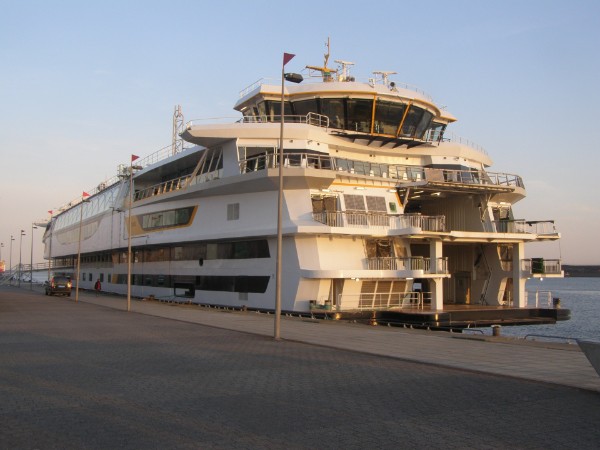
Construction and general statistics
The keel for the Texelstroom was laid at the 30th of december 2014, which in fact was the placing of the first buildingblock. Under the block, two coins were laid for good luck, a Dutch guilder from TESO's year of foundation 1907 and a guilder from the year when the wife of the projectleader was born. The ship was launched traditionally at the 30th of july 2015 and the timing had to be perfect for the right waterlevel in the Nervion river. In TESO tradition, the namingcermony was performed by the wife of the companies director, Kiran De Waal-Sukhai. The ship has a lenght of 135,40 meters, some 5 meters more then her older fleetmate Dokter Wagemaker. Her width is 27,90 meters and a draught of 4,3 meters. Due to restrictions at the ports she will sail from, it was impossible to make the ship larger then she became. Despite that, her capacity is slightly up from her forerunner, as she will be able to carry 1750 passengers. On the upper cardeck, the ship has a capacity of 209 cars and on the lower cardeck, there is space for two cars from disabled passengers next to 169 other cars. It is also possible for 34 trucks to be placed here, then there will be space for 50 additional cars. In total, the ship has two cardecks, one bicycledeck and one passengerdeck. For power, the ship has four engines, two ABC Diesel engines and two ABC dual-fuel engines. They turn two azimuth-propellers designed by Rolls Royce and giver her a maximum speed of 15 knots, although mostly she will be operating at 10 knots, good enough for the 20-minute crossing. It is planned that Texelstroom will be the operational ship untill 2030 and afterwards untill 2040 she will be the reservevessel. When she enters service, The Dokter Wagemaker of 2005 will become the reservevessel and the other ship, Schulpengat, will be sold.
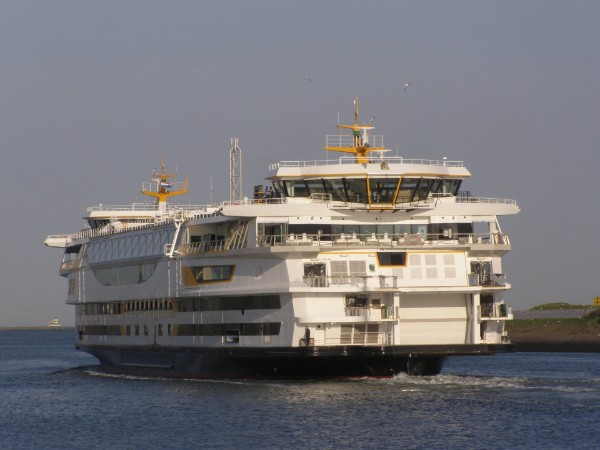
Texelstroom was towed across the Nervion river at the 26th of february of 2016 from the wharf to the drydock at Santurzi, a little upstream. For her fitting out, the ship was moved to Santander, from where she departed at wednesday the 13th of april for Amsterdam, arriving there at the 20th of april. Here, the last fitting out and paintingwork was done at Shipdock, before the ship sailed for IJmuiden, the first time under her own power, at the 7th of may for the start of her week-long seatrials beginning the next day.
Texelstroom as seen leaving Texel for Den Helder at the 21st of july, 2020.
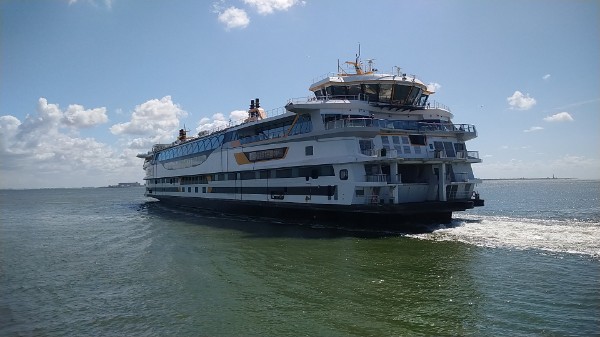
Design
Texelstroom, as said, is one of the most innovative and environmentalfriendly short-haul passengerferries in the world. For her design, some 600 suggestions were collected, made by crew, operational management, TESO shareholders, service-users and students. She was designed by the Dutch companies C-Job for the marine technology and Vripack, together with the local Basque designer Oliver Design for the interiour and exteriour design. She is the first ferry in the world that uses CNG gas for propulsion. Of the ships four engines, one will run solely on CNG (Compresses Natural Gas) and mostly, the ship will only use this engine. Gas produced can be stored aboard in batteries for later use and it will be possible to make a crossing on stored gas in every situation. So a possible engine fallout is not a problem with this ship, as she will always be able to sail. During nighttime when the ship is not sailing, it is also not needed to heat the ship as reserveheat retracted from the coolingwater can be used to keep a good temperature without running engines. This feature of course saves a lot of energy. For extra energy, the ship will also be equipped with some 700 square meters of solarpanels at her topdeck to make her even less dependent on fossil fuels.
Because of the nature of the ship and the intensive use and number of crossings, the ship has two enginerooms and two wheelhouses so she will not have to turn around saving time. The two systems can be run seperately, so when one will not be able to be operated, the other system can fill in.
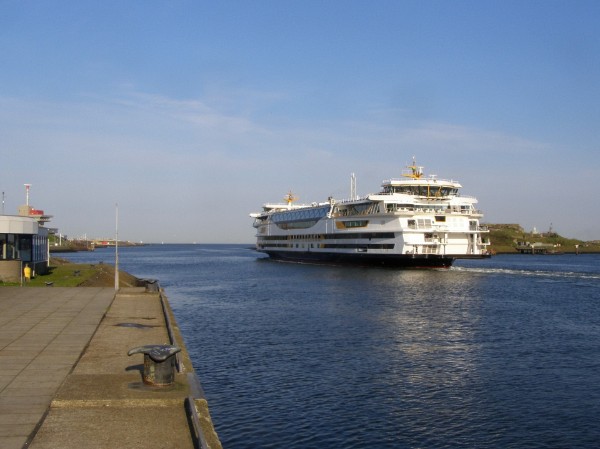
Texelstroom has a wider upper cardeck then Dokter Wagemaker, making it possible to ferry more cars at the same time on two extra roro-lanes without the ship looking larger. Only the upper cardeck is widened, as the docks at Texel and Den Helder cannot cope with wider ships lower down. Next to this, the placing of the wheelhouses is lower, there is no atrium with a dome and the funnels are smaller still giving the ship a smaller look. In the design, also the environment that the ship will sail in was an inspiration. Natural and soft lines will resemble the tides and waves of the distinctive strech of water she crosses. The Waddenzee is recognized as a UNESCO World Heritage site and very delicate. One of the inspirations for her lines is also a local bird, the Little Tern. The sheer of the ship is partially based on the form of the wing of this bird, as well as on the distinctive sheer of the first Texelstroom the company sailed with, built in 1966.
After her first day of trials at the 8th of may, the ship returned exactly as sceduled.
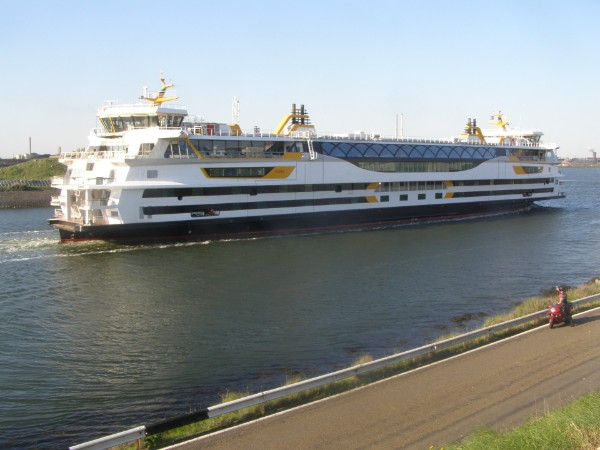
The key elements for her interiour design are transparancy as the lounges are created to be very open, symetric spaces, freedom and purity. The last key element was incorporated in the design by using environmentfriendly materials and colours that are relating to the environment she sails in. The main colours used are green, sand, blue and grey. The colours of the grass, water, dunes and sky. Her passengerdeck will have two main lounges, separated by a buffetarea. The glasspanels looking out over the sea are supported by arches that are based on the outside of a pine cone. A closer look at her interiour spaces can be seen here.
A video of the launch of the Texelstroom van be viewed via youTube here, provided by the Basque newspaper Berria.
Carreer
The first arrival of the new ferry was at the 26th of may 2016 at Texel's port 't Horntje and at the 18th of june, the ferry was officially presented in the port. This day it was possible for visitors to take a tour of the new ship and there were introduction speakers to the likes of Hennie Huisman (the loco-mayor of Texel), Vicente Dieguez (director of Lanaval), Cees de Waal (director of TESO) and Frank van der Broeck (commissioner of TESO). Also, there was a musical interlude. This day, the ship was officially delivered to TESO, but her sailings only started on the 28th of october to avoid possible introductionproblems during the most busy months of the service. In january 0f 2017, the ship indeed suffered some propulsionproblems and was temporarely replaced by the Schulpengat.

